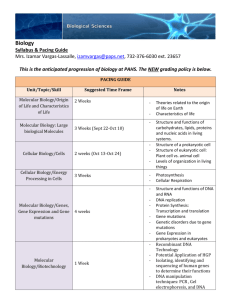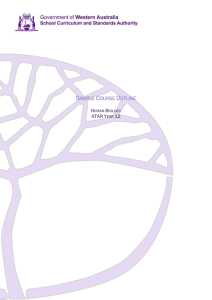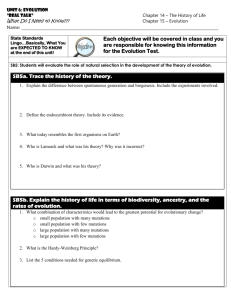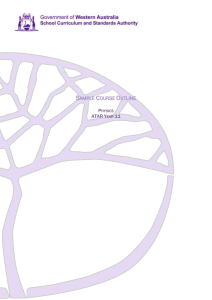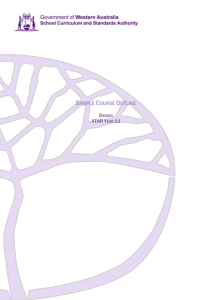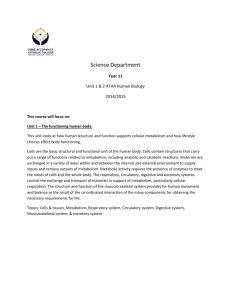Sample course outline - WACE 2015 2016
advertisement
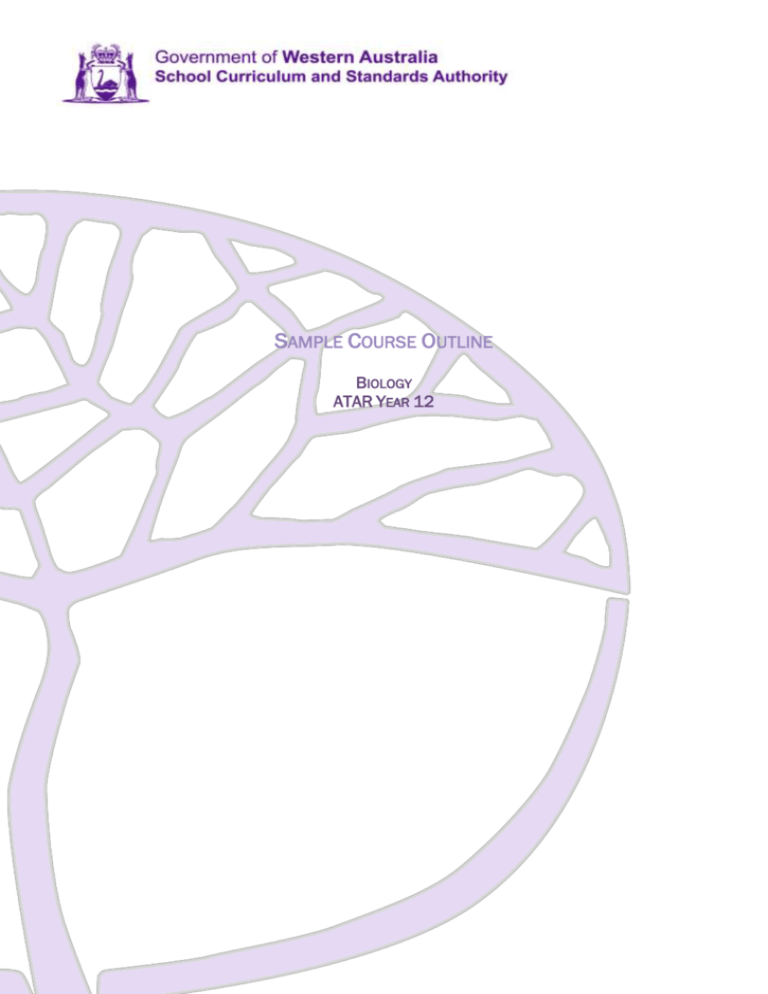
SAMPLE COURSE OUTLINE BIOLOGY ATAR YEAR 12 Copyright © School Curriculum and Standards Authority, 2015 This document – apart from any third party copyright material contained in it – may be freely copied, or communicated on an intranet, for non-commercial purposes in educational institutions, provided that the School Curriculum and Standards Authority is acknowledged as the copyright owner, and that the Authority’s moral rights are not infringed. Copying or communication for any other purpose can be done only within the terms of the Copyright Act 1968 or with prior written permission of the School Curriculum and Standards Authority. Copying or communication of any third party copyright material can be done only within the terms of the Copyright Act 1968 or with permission of the copyright owners. Any content in this document that has been derived from the Australian Curriculum may be used under the terms of the Creative Commons Attribution-NonCommercial 3.0 Australia licence Disclaimer Any resources such as texts, websites and so on that may be referred to in this document are provided as examples of resources that teachers can use to support their learning programs. Their inclusion does not imply that they are mandatory or that they are the only resources relevant to the course. 2014/28498v4 1 Sample course outline Biology – ATAR Year 12 Unit 3 and Unit 4 Semester 1 – Continuity of species Week Key teaching points 1 Heredity The genetic code structure of DNA replication 2 Protein synthesis transcription and translation gene expression 3–4 DNA technologies DNA sequencing DNA profiling recombinant DNA technologies and their application (transgenic organisms) Task 1: Gel electrophoresis – a practical activity with a summary report and an in-class validation 5 Cell reproduction mitosis meiosis variations as a result of meiosis 6 Mutations causes of mutations gene mutations chromosome mutations 7–8 Patterns of inheritance dominance autosomal alleles sex-linked alleles multiple alleles polygenes Task 2: Heredity – 40-minute test 9 Continuity of life on Earth fossil evidence the geological time scale Task 3: Fossils and evolution – an extended response consisting of one week of research, followed by an in-class validation based on the research 10 Evidence for evolution comparative genomics (molecular evidence) technological developments in the fields of comparative genomics, comparative biochemistry and bioinformatics comparative anatomy and embryology phylogenetic trees 11–12 Natural selection sources of variation natural selection gene flow and genetic drift artificial selection Task 4: Changing a gene pool – a scientific report based on developing and conducting a simulation Sample course outline | Biology | ATAR Year 12 2 Week Key teaching points game with two sets of rules 13–14 15 Speciation causes of speciation allopatric speciation examples of speciation types of evolution (convergent, divergent) Environmental conservation populations with reduced genetic diversity face increased risk of extinction effects of using transgenic organisms on genetic diversity and the environment use of biotechnology in environmental conservation conservation planning to maintain viable gene pools Task 5: Continuity of life on Earth – 40-minute test Task 6: Semester 1 Examination Semester 2 – Surviving in a changing environment Week Key teaching points 1–3 Homeostasis stimulus response model Living in a terrestrial environment Case studies: endotherms, e.g. mammals, birds ectotherms, e.g. arthropods, reptiles Challenges faced by terrestrial organisms living in an arid environment thermoregulation water and salt balance Task 7: Temperature regulation in animals – an investigation into thermoregulatory mechanisms 4–5 Living in an aquatic environment Case studies: endotherms, e.g. mammals (whales, dolphins); birds (penguins and other sea-dwelling birds) ectotherms, e.g. freshwater and marine fish, amphibia, reptiles Challenges faced by organisms living in an aquatic environment thermoregulation water and salt balance 6–7 Xerophytes and halophytes Case studies: xerophytes halophytes Task 8: Homeostasis – 40-minute test 8 Infectious disease Nature of disease terminology transmission of disease major groups of pathogens – structural characteristics spread of disease involves a range of interrelated factors susceptibility of urban areas to epidemics and pandemics Activity: http://www.csiro.au/helix/sciencemail/activities/infection.html Sample course outline | Biology | ATAR Year 12 3 Week Key teaching points 9 Bacteria types of bacteria diseases caused by bacteria – tuberculosis, tetanus, crown gall of plants Task 9: Modelling an outbreak of a disease – The Nuffield Foundation, Spread of infectious diseases, Activity 4.1 Protecting the herd 10 Fungi types of fungi diseases caused by fungi – amphibian chytrid fungus Task 10: Amphibian chytrid fungus disease – an extended response consisting of one week of research, followed by an in-class validation based on the research 11 Protists types of protozoans diseases caused by protists – malaria, Phytophthora dieback disease 12 Viruses types of viruses diseases caused by viruses – Ross River virus, influenza viruses, Australian bat lyssavirus, viral disease of the honey bee 13 the effect of climatic changes on the distribution of mosquito-borne diseases, e.g. Ross River virus evolution of pathogens – emerging viral diseases using modelling to establish the incidence and spread of disease 14 management strategies the importance of quarantine for agriculture and the environment international cooperation and communication Task 11: Infectious disease – 40-minute test 15 Task 12: Semester 2 Examination Sample course outline | Biology | ATAR Year 12




